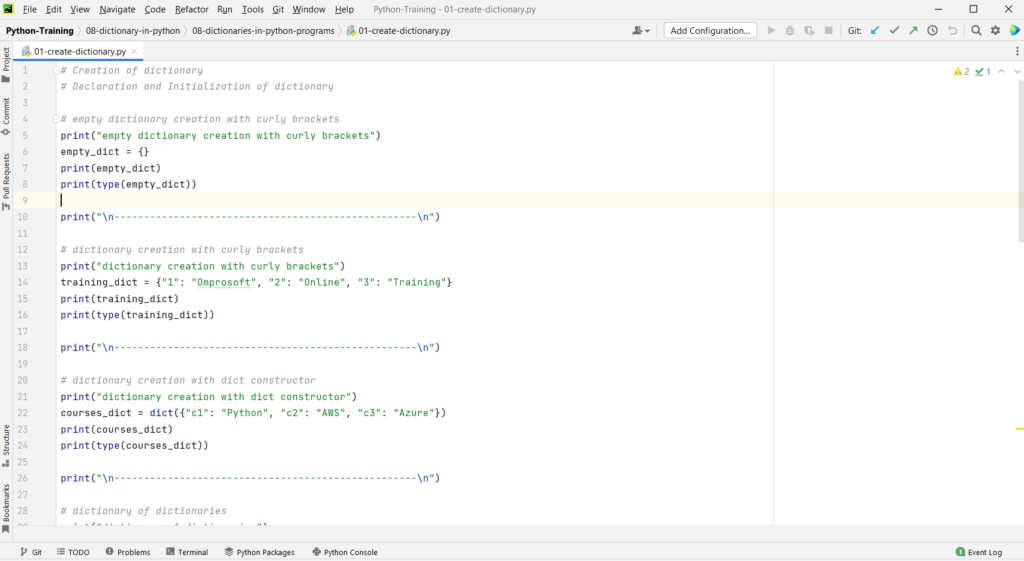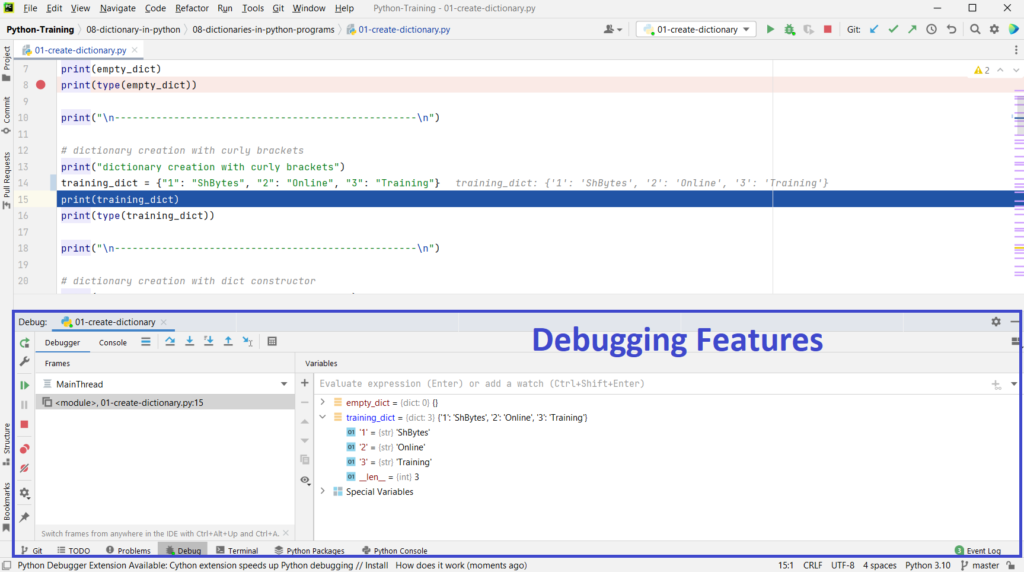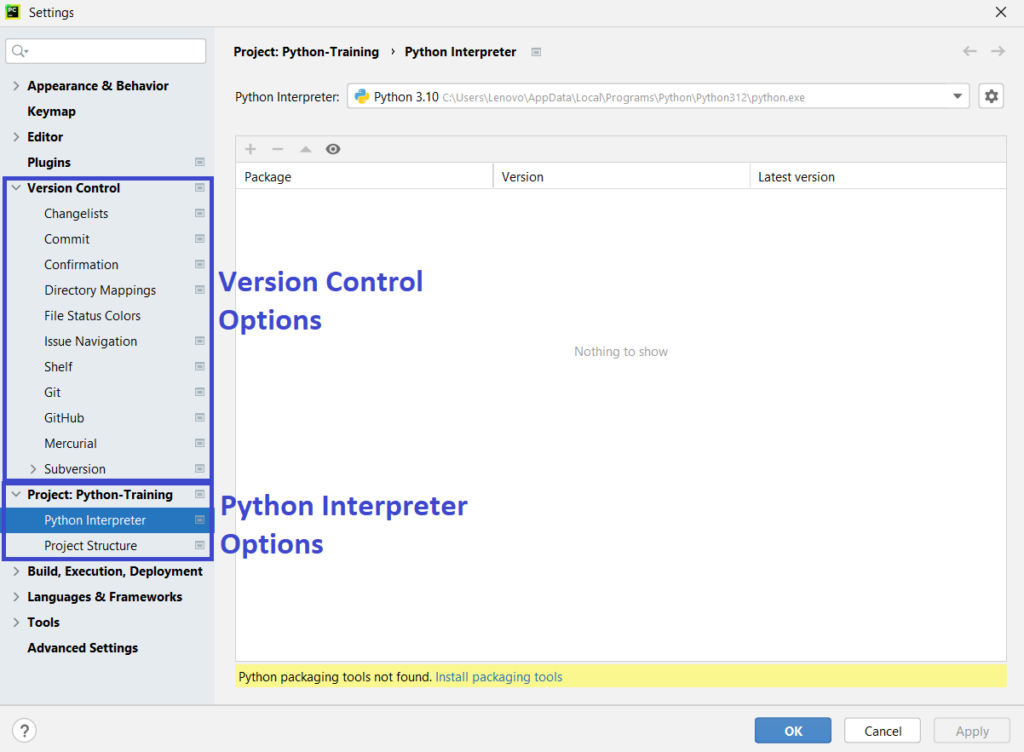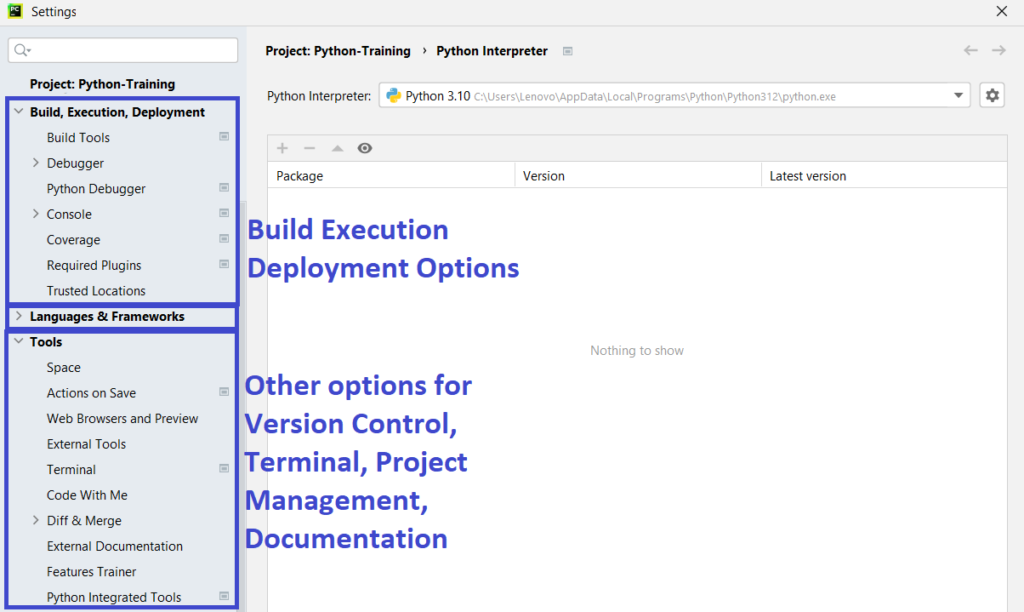What is an IDE (Integrated Development Environment)
An Integrated Development Environment (IDE) is a robust software tool (application) that helps programmers and developers write code more efficiently. It combines multiple features such as code editing, building, testing, and packaging into a single user-friendly interface application, to significantly boosts software developers productivity.
This is very similar to how writers use text editors or word documents and accountants rely on spreadsheets. Software developers utilize Integrated Development Environments (IDE) to streamline their work.
Popular IDEs by Language
Some of the popular IDEs for different programming languages like Java, Python and C# are:
- Python => PyCharm, Visual Studio Code, and JupyterLab are top choices, offering robust debugging, autocomplete, and data visualization tools.
- Java => IntelliJ IDEA is the go-to, known for its advanced refactoring tools, followed by Eclipse and NetBeans.
- JavaScript => Visual Studio Code dominates with its extensions and real-time collaboration features, while WebStorm is preferred for Angular and React development.
- C/C++ => Visual Studio, CLion, and Code Blocks excel in providing cross-platform support and efficient debugging.
Each IDE enhances productivity by tailoring features to the language’s needs.
Key Features & Capabilities of an IDE
Text editors like Notepad++, Sublime Text and Atom can be used to write code, but they lack the advanced features and functionality needed for comprehensive software development. Most Integrated development environments (IDEs) offer more features than just text editing.
IDEs provide a unified interface for various developer tools, streamlining the software development process. Here are the key features and capabilities of an IDE:
Code Editor
Code editing is the core component of any IDE. An IDE includes integrated build rules specific to programming languages, which enable intelligent features such as auto-completion and source code editing.
In addition, IDEs offer features like syntax highlighting, code completion (often enhanced by AI), and real-time error detection to streamline the process of writing and editing code.

Auto-Completion of Code
Auto-completion of code is a feature in coding environments that helps developers write code faster and with fewer errors. As you type, the tool suggests the next part of the code, such as functions, variables, or keywords, based on context and previous inputs. This reduces the need to remember syntax, improves accuracy, and speeds up development. It’s especially helpful in larger projects, where it minimizes mistakes and ensures consistent code formatting.
Debugger
Debugging involves identifying and resolving errors or bugs found during testing. One of the key advantages of using an IDE for debugging is its ability to execute code line by line, enabling users to observe, inspect variables, set breakpoints, and trace the program’s execution flow. Additionally, IDEs come equipped with various debugging tools that can highlight errors in real time, even as the developer is typing.

Compiler/Interpreter
An IDE includes tools to compile or interpret code into machine language that the operating system can execute.
Some programming languages, like Java, use just-in-time (JIT) compilation, where the IDE converts human-readable code into machine code at runtime within the application.

Version Control Integration
IDEs offer support and built-in integration with various version control systems such as Git, GitHub, Mercurial, Subversion.
This integration allows developers to efficiently manage different versions of their source code, track changes over time, and maintain a comprehensive history of modifications. Developers can perform essential version control tasks like committing changes, branching, merging, resolving conflicts, and pushing/pulling updates directly from the IDE interface.
Additionally, IDEs include visual tools for comparing file revisions, reviewing change histories, and managing branches, providing an efficient workflow for version control tasks
Build Automation Tools
IDEs support tools and scripts for automating common tasks such as compiling code, running tests, and packaging applications. Writing code involves multiple repetitive tasks that developers need to perform frequently. Automating these common tasks increases developers’ productivity.

Additional Features of IDEs
Beyond core functionalities, IDEs offer several advanced tools to support software development:
Refactoring Tools
Refactoring tools in an IDE enable developers to efficiently restructure code without changing its external functionality, enhancing both readability and maintainability.
These tools automate complex tasks such as renaming variables, extracting methods, and reorganizing code blocks, ensuring that the code remains consistent and free of errors throughout the process.
By streamlining repetitive tasks and providing real-time feedback on potential issues, refactoring tools help developers systematically improve their code base, reducing technical debt and making it easier to add new features or debug existing ones
Project Management
Project management in an IDE offers a suite of tools and functionalities that facilitate the efficient organization and navigation of software projects. With project management features in IDEs, developers can create and manage projects consisting of multiple files, directories, and resources.
These features include:
- Project templates for quick setup
- Hierarchical views of project structure for easy navigation
- Tools for adding, renaming, moving, and deleting files within the project
- Integrated search and navigation capabilities across project files to locate specific code snippets or resources
Project management capabilities in IDEs boost productivity by providing developers with a unified environment to manage and work on their software projects efficiently.
Unit Testing Integration
This includes tools to write, run, and debug unit tests, ensure code quality and functionality.
Unit Testing Integration within an IDE provides multiple features tailored to enhance software quality and functionality verification at the unit (functional) level. Unit testing integration generally supports popular testing frameworks such as JUnit for Java, NUnit for .NET, unittest for Python offering seamless integration with the code editor and build automation tools.
Benefits provided by Unit Testing Integration within an IDE are:
- Enables developers to effortlessly create, execute, and debug unit tests directly within IDE
- Developers can write test cases alongside their code
- Developers can leverage features like intelligent code completion and syntax highlighting for test assertions
- It provides immediate feedback on code behavior, identifying potential issues
- Developers can use debugging capabilities with unit testing
Unit Testing Integration empowers developers to maintain code quality, validate expected behaviors. It also helps to achieve Test-Driven Development (TDD) approach. Unit testing integration helps in improving software reliability and maintainability.
Integrated Terminal
The integrated terminal within an IDE provides a command-line interface directly inside the development environment. This allows developers to execute various commands and run scripts within the context of their project, eliminating the need to switch to an external terminal window.
The integrated terminal in an IDE offers several benefits for software developers:
- Enhances productivity by allowing quick access to system-level operations such as file management, version control commands, package management, and running build scripts.
- Enables direct interaction with the operating system.
- Facilitates tasks like environment setup and debugging directly within the IDE.
- Supports customization, allowing developers to configure shell preferences.
- Manages multiple terminal instances and leverages command history for efficient workflow management.
This feature is especially valuable for developers working on multiple projects who need direct control over their development environment without disrupting their coding flow.

Code Snippets
- The code snippets feature in an IDE allows developers to easily save and reuse frequently used code fragments or templates.
- These snippets can vary from small segments like variable declarations or function headers to larger blocks, such as entire loops or classes.
- IDEs typically support snippet customization, enabling developers to create their own libraries based on specific coding patterns and project requirements.
Plugins and Extensions
IDEs support additional plugins and extensions.
- Plugins and extensions help extend the core functionality of the environment, allowing developers to customize the development environment to meet specific needs.
- These plugins and extensions can include language support and frameworks, version control systems, testing tools, cloud integration, and monitoring tools.

User Interface Design Tools
- User interface design tools in IDEs are specifically designed for developers working on graphical user interfaces (GUIs).
- These tools typically include a graphical layout editor, allowing developers to visually design their interfaces using a drag-and-drop features.
Documentation and Help System
- The documentation and help system in an IDE serves as a vital resource hub for developers.
- It offers access to API references, language specifications, and user guides. Additionally, it provides contextual assistance, including access to documentation, tutorials, and help systems directly within the IDE.
This feature not only boosts productivity by minimizing the time spent on external research but also helps developers stay updated with the latest knowledge and best practices throughout the software development process.
Conclusion
IDEs are essential for modern software development, offering a unified platform for writing, debugging, compiling, and managing projects. Popular IDEs such as IntelliJ IDEA, PyCharm, Visual Studio, Eclipse, and JupyterLab cater to various programming languages, making coding more efficient and organized.
Interview Questions & Answers
Q: What is IntelliSense, and how does it benefit developers in an IDE?
IntelliSense is a code-completion and suggestion feature. This features is available in multiple IDEs like IntelliJ, Visual Studio Code etc. IntelliSense provides real-time suggestions and information with the typing of initial letters of the command and based on the context of the code. Multiple benefits of IntelliSense:
- Speeds Up Development for application
- Reduces Errors in code writing
- Improves Code Accuracy
- Enhances Learning
- Inline Documentation Access
Q: Explain the concept of “live code analysis” in an IDE?
Live code analysis is a feature in modern Integrated Development Environments (IDEs) that continuously monitors and analyzes the written code. It provides immediate feedback on potential issues, errors, or improvements. Key Features of Live Code Analysis:
- Syntax Checking
- Code Quality Warnings
- Code Style Enforcement
- Real-time Feedback
- Security Analysis
- Error Highlighting
Test Your Knowledge: Practice Quiz
Related Topics
- Understanding Scope in Python Programming (with Example Programs)In previous articles, we learned about following topics: Understanding Scope in Programming Generally, in the scope of a program, a variable can be declared only once with the same name. But, it’s possible to declare variables with the same name in different scopes within the same program. Changing the value of a variable within a…
- Understanding Number Datatype in Python: Decimal, Octal and Hexadecimal NumbersUnderstanding the Number Datatype in Python: A Comprehensive Overview Number datatype in Python is a combination of different number format classes like Integer, Float, and Complex. Python supports the Decimal, Octal decimal, and Hexadecimal number systems. Program – Integer Number datatype Output of the Integer Number datatype program: Note from the output: Exploring Float Number…
- Introduction to Variables in Python & Variable Data TypesWhat are Variables in Python In Python, variables act as references to reserved memory locations where actual values are stored. Each variable name points to a specific memory address that holds the assigned value. In this case: How Variable Memory Works When we define variables, like height = 175, Python allocates a specific memory location…
- What Are Comments and Docstring in Python (With Programs)?Before we start learning about Comments and Docstring in Python and its concepts, we should setup our Python Integrated Development Environment (IDE) on our local machine. Read through the following articles to learn more about What is an IDE, Popular IDEs for Python and Python installation on your machine. Introduction to Comments in Python In…

I like the helpful information you provide in your articles.
I will bookmark your blog and check again here regularly.
I am quite certain I will learn lots of new stuff right here!
Best of luck for the next!